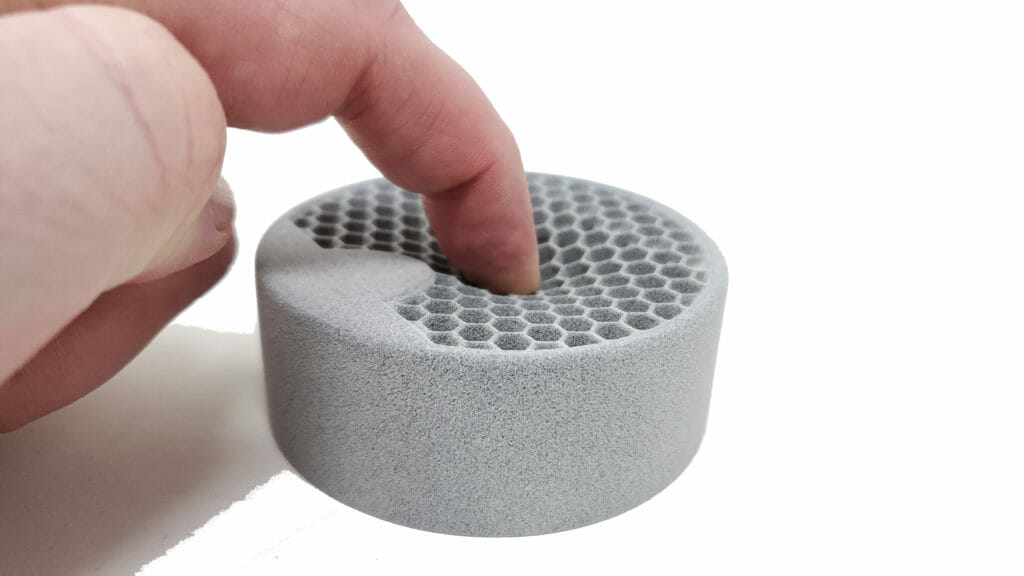
In the world of Additive Manufacturing and 3D printing there are many options for those who need 3D printed rubber parts, but just like most things not all materials are made equal. For example:
- HP Multi Jet Fusion (MJF) Rubber parts are great for end use and low volume part production applications
- SLA rubber parts have some limited end use applications, also good for prototyping parts
- CLIP / DLP Can build small rubber parts that are for end use or prototypes
- Polyjet Rubber parts work great for prototypes
- Fused Deposition Modeling (FDM) Rubber parts can be built very large
- Selective Laser Sintering (SLS) rubber parts should just be avoided all together if possible in our experience!
The following is a break down of each of these materials, their physical properties, what they are commonly used for, and what uses should be avoided:
HP MJF Printed Rubber Parts:
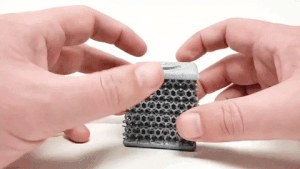
The HP MJF process is extremely well suited for producing end use rubber parts in quantities that enable low volume / bridge production of parts at an economically viable cost. This allows for them to be considered against traditional manufacturing solutions for rubber part production like urethane casting or aluminum injection mold tools. Click here for more detailed information on M95A TPU Rubber.
Common end uses HP MJF 3D Printed Rubber Parts:
- Flexible parts like tubes, hoses, and ducts
- Caster or small rim rubber wheels / tires
- Grips for things like bikes, consumer products, and sporting goods
- Custom shock absorbers and springs
- Flexible lattice structures
- All types of rubber or TPU automotive parts (material is strong enough to work on end use parts)
- Shoe soles, orthopedic inserts, orthodontic applications
- Specialized plugs and connectors for electrical / pneumatic applications
- Custom gaskets, seals
- Functional and design prototypes
Limitations of this material:
- Limited to 95A material hardness
| Mechanical Properties | Values | Unit | Test method | |
| Specific Gravity | 1.10 - 1.15 | - | ASTM D-792 | |
| Properties in X | Properties in Z | |||
| Hardness (5 sec) | 90 | 90 | Shore A | ASTM D-2240 |
| Abrasion Volume Loss | 100 (140) | 100 (140) | mm3 | DIN-53516 / ISO-4649 |
| Tensile Strength | 17 (11) | 8 (5) | MPa | DIN-53504 / ISO-37 |
| Elongation at Break | 400 (180) | 90 (30) | % | DIN-53504 / ISO-37 |
| Tear Strength (Die C) | 80 (80) | 35 (33) | KN/m | ASTM D-624 |
| Flexural Modulus | 85 | - | MPa | ASTM D-790 |
| Dimensional Accuracy in XY | +/- 1.0 | mm | ||
| Thermal Properties | ||||
| Thermal testing is still in the early phases, but this material can be heated to 392F (200C) for over 18 hours without melting (tensile strength will be reduced by 60% from a room temperature sample). When kept at or below 248F (120C) indefinitely there is a negligible effect to both tensile strength and elongation at break. Contact us for more detailed temperature effect data. | ||||
Click here for a downloadable version of this material data sheet.
SLA Printed Rubber Parts:
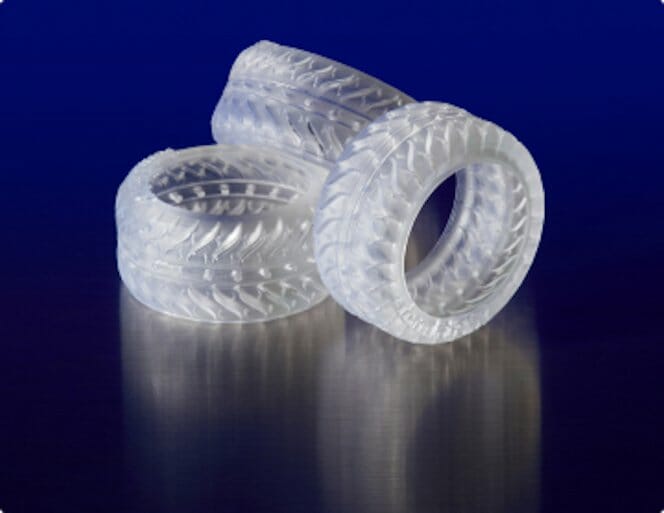
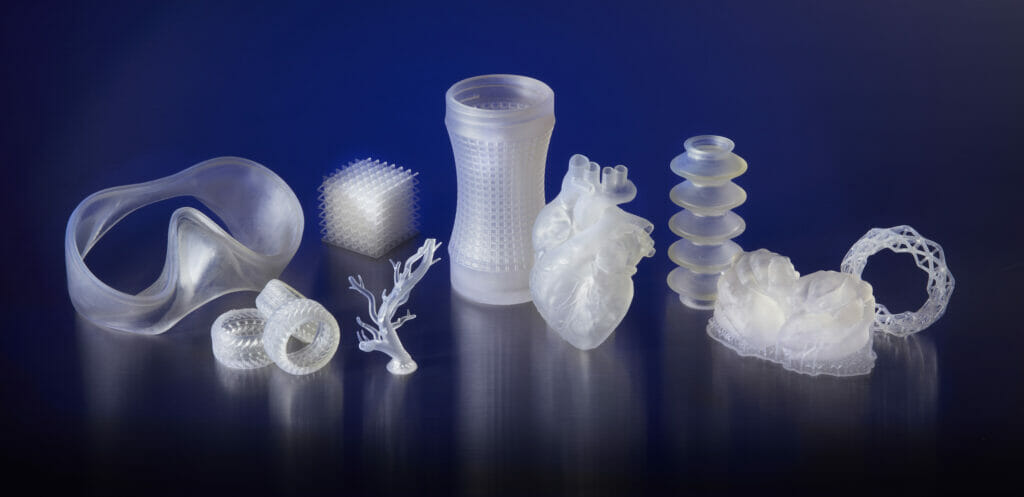
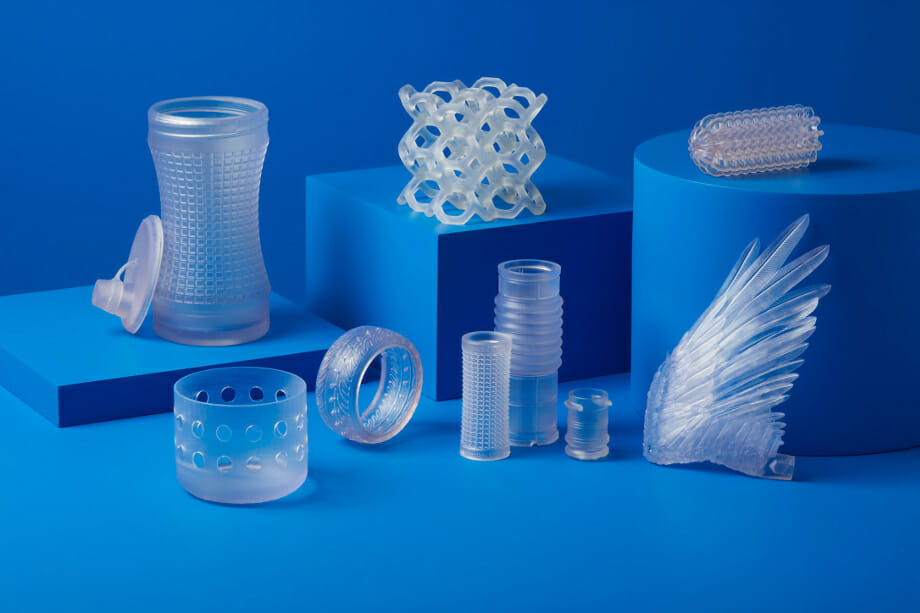
SLA rubbers are good for prototyping and some limited end use applications. There are 2 material options for 3D printable rubbers on this type of machine Flexible 80A and Elastic 50A. Both of these materials can be considered for low volume end use applications in room temp indoor environments.
Common uses for SLA 3D Printed Rubber Parts:
- Consumer goods prototyping
- Soft touch features for robotics
- Medical devices and anatomical models
- Special effects props and models
- Wearables, such as straps
- Compressible buttons
- Stretchable enclosures and casings
- Soft tissue anatomy
- Handles, grips, and overmolds
- Cushioning, damping, and shock absorption
- Seals, gaskets, and masks
- Cartilage, tendon, and ligament anatomy
Limitations of this material:
- Material is not UV stable and will discolor when overexposed for extended periods of time
- Printed bed for this SLA machine is small so parts can’t be that large
- Not well suited for use for low volume manufacturing due to high cost
SLA – Flexible 80A Technical Specifications:
| MATERIAL PROPERTIES DATA | |||
| Metric | ENGLISH | METHOD | |
| Tensile Properties | |||
| Ultimate Tensile Strength | 8.9 MPa | 1290 psi | ASTM D 412-06 (A) |
| Stress at 50% Elongation | 3.1 MPa | 433 psi | ASTM D 412-06 (A) |
| Stress at 100% Elongation | 6.3 MPa | 909 psi | ASTM D 412-06 (A) |
| Elongation at Break | 120% | ASTM D 412-06 (A) | |
| Tear Strength | 24 kN/m | 137 lbf/in | ASTM D 395-03 (B) |
| Shore Hardness | 80 A | 80 A | ASTM 2240 |
| Compression Set (23 °C for 22 hours) | 3% | 3% | ASTM D 624-00 |
| Compression Set (70 °C for 22 hours) | 5% | 5% | ASTM D 395-03 (B) |
Click here for a downloadable version of this material data sheet.
SLA – Elastic 50 A Technical Specifications:
| MATERIAL PROPERTIES DATA | |||
| Metric | ENGLISH | METHOD | |
| Tensile Properties | |||
| Ultimate Tensile Strength | 3.23 MPa | 468 psi | ASTM D 412-06 (A) |
| Stress at 50% Elongation | 0.94 MPa | 136 psi | ASTM D 412-06 (A) |
| Stress at 100% Elongation | 1.59 MPa | 231 psi | ASTM D 412-06 (A) |
| Elongation at Break | 160% | ASTM D 412-06 (A) | |
| Tear Strength | 19.1 kN/m | 109 lbf/in | ASTM D 624-00 |
| Shore Hardness | 50A | 50A | ASTM 2240 |
| Compression Set (23 °C for 22 hours) | 2% | 2% | ASTM D 395-03 (B) |
| Compression Set (70 °C for 22 hours) | 9% | 9% | ASTM D 395-03 (B) |
Click here for a downloadable version of this material data sheet.
CLIP / DLP Printed Rubber Parts:

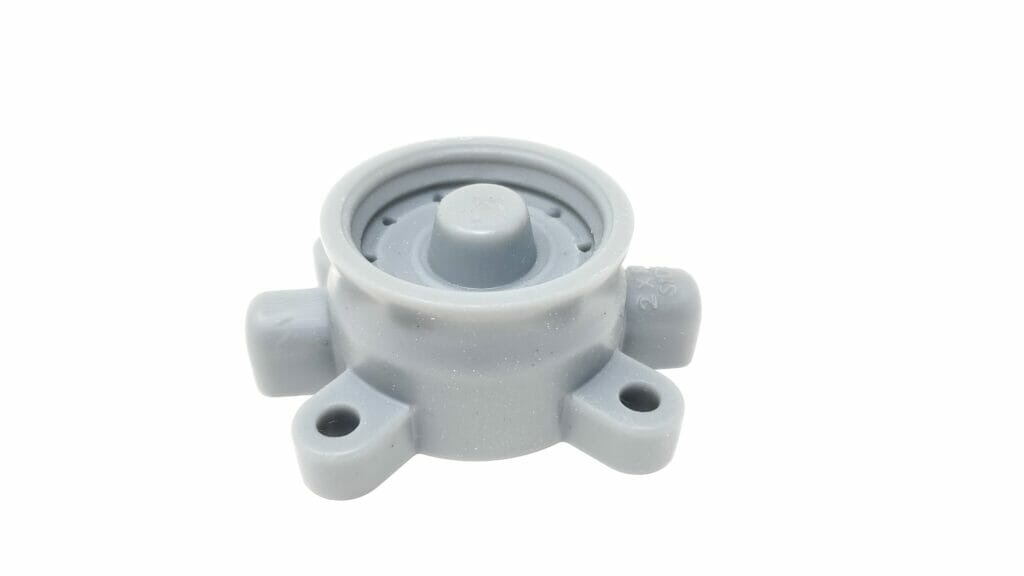

CLIP / DLP rubbers are very durable and great for end use applications. There are 3 different options available LOCTITE IND402, EPU 40, SIL. They offer a range of durometers and can hold up to very aggressive environments.
Common uses for SLA 3D Printed Rubber Parts:
- Consumer products
- Functional prototyping
- Shoe Insoles
- Lattice structures for sportswear
- Production parts
Limitations of this material:
- Printed bed for these machines are small so parts can’t be that large
- Not well suited for use for low volume manufacturing due to high cost
DLP – LOCTITE IND402 Technical Specifications:
| TYPICAL PHYSICAL PROPERTIES | |
| MECHANICAL PROPERTIES | METRIC |
| Tear Strength | 28 kN/m |
| Young's Modulus | 42 MPa |
| Elongation at Break | 230% |
| Energy Return | 33% |
| Shore D Hardness | 76 D |
| Stress at Break | 6.1 MPa |
Click here for a downloadable version of this material data sheet.
DLP – EPU 40 Technical Specifications:
| TYPICAL PHYSICAL PROPERTIES | ||
| MECHANICAL PROPERTIES | ENGLISH | METRIC |
| Tensile Modulus | 1200 psi | 8 MPa |
| Stress at 50% Elongation | 290 psi | 2 MPa |
| Ultimate Tensile Strength | 2700 psi | 19 MPa |
| Stress at 200% Elongation | 870 psi | 6 MPa |
| Shore Hardness | 71 A | |
| Elongation at Break | 400% |
Click here for a downloadable version of this material data sheet.
DLP – SIL Technical Specifications:
| TYPICAL PHYSICAL PROPERTIES | ||
| MECHANICAL PROPERTIES | ENGLISH | METRIC |
| Tensile Modulus | 440 psi | 3 MPa |
| Stress at 200% Elongation | 220 psi | 1.5 MPa |
| Ultimate Tensile Strength | 500 psi | 3.5 MPa |
| Tear Strength, Die C | 57 lbf/in | 10 kN/m |
| Shore Hardness | 31 A | |
| Elongation at Break | 350% |
Click here for a downloadable version of this material data sheet.
Polyjet Printed Rubber Parts:
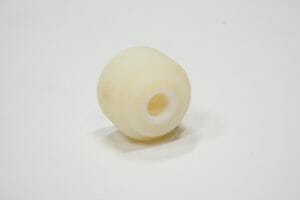
Agilus30 is a superior Rubber-like PolyJet photopolymer ideal for advanced design verification and rapid prototyping. One of the primary benefits over older generation Tango PolyJet materials is over 200% more flex before tearing. Agilus30 accurately simulates the look, feel, and function of Rubber-like products. It is available in harnesses ranging from Shore A values 30-95. Click here for more information on Agilus30.
Common prototype uses for Polyjet 3D Printed Rubber Parts:
- Rubber surrounds and over molding
- Parts that have living hinges
- Wearables and footwear
- Soft-touch coatings and nonslip surfaces
- Knobs, grips, pulls, handles, gaskets, seals, and hoses
- Exhibition and communication models
- Simulates injection molded parts with both hard and soft components.
Limitations of this material:
- Material is not UV stable and will discolor when overexposed for extended periods of time
- Meant to be used only for prototype applications
- Not well suited for use for low volume manufacturing due to high cost
- This material can not be painted due to a chemical reaction that will harden the rubber
- It is recommended not to expose Agilus30 to water for longer than one hour, as this will weaken the material and produce less than desired performance.
| Agilus30 Mechanical Specs | |||
| Mechanical / Thermal Properties | |||
| ASTM Method | Property Description | Metric | Imperial |
| D-412 | Tensile Strength | 2.4 – 3.1 MPa | 348 – 450 psi |
| D-412 | Elongation at Break | 220 – 270% | 220 – 270% |
| D-2240 | Shore Hardness (A) | 30 – 35 Scale A | |
| D-624 | Tensile Tear Resistance | 4 – 7 Kg/cm | 22 – 39 lb/in |
Click here for a downloadable version of this material data sheet.
FDM 3D Printed Rubber Parts:

FDM TPU 92A Elastomer is a thermoplastic polyurethane material developed to enable the production of durable elastomer parts with additive manufacturing. It has a Shore A hardness of 92 durometer. This material enables prototyping of high functioning, durable, and complex parts. It is possible to produce large thermoplastic polyurethane parts with FDM TPU 92A Elastomer with good tear resistance, fatigue, memory, and recovery associated with elastomeric materials.
Common prototype uses for FDM 3D Printed Rubber Parts:
- Door trim & seals
- Hoses & tubes
- Airducts & bellows
- Seals, gaskets, & grommets
- Windshield & side glass trim
- Console liners & cup holders
- Body panel seals & gap hiders
- Grips & surface protection covers
- Parts requiring living hinges
- Dust covers
Limitations of this material:
- The parts are not air / vacuum tight
- Parts can only be printed with 80% infill and can’t be printed solid or spare
- Meant to be used only for prototype applications
- Not well suited for use for low volume manufacturing due to high cost
- Will swell up to 0.5% when exposed to wet / humid conditions
| Mechanical Properties | Test Method | XY Orientation | XZ Orientation |
| Shore Hardness | ASTM D2240 | 92 Shore A | |
| Tensile Strength | ASTM D412 | 16.8 MPa (2,432 psi) | 17.4 MPa (2,519 psi) |
| Elongation at Break | ASTM D412 | 552% | 482% |
| Tear Strength | ASTM D624-C | 84.6 N/mm (483 lbF/in) | NA |
| Flexural Modulus | ASTM D790 | 25.6 MPa (3,719 psi) | 36.9 MPa (5,349 psi) |
| Heat Deflecton (HDT) @ 66 psi | ASTM D648 | 38 ºC (100.4 ºF) |
Click here for a downloadable version of this material data sheet.
SLS 3D Printed Rubber Parts:
After much experimentation we determined SLS 3D Printed Rubber parts to be totally inferior to the other options we offer that are listed above.
The major downsides we found were:
- Low resolution / poor detail / bad accuracy.
- Very limited build z height (parts tend to warp and twist in tall builds).
- Parts are not air / vacuum tight.
- Parts tend to break down / crack / flake apart when flexed.
For these reasons we no longer offer this option to our customers. If you are dead set on getting and SLS rubber part feel free to reach out to us and we would be happy to refer you to another service bureau who could help you out with this.